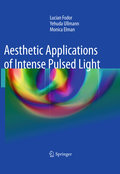
Aesthetic applications of intense pulsed light
Fodor, Lucian
Elman, Monica
Ullman, Yehuda
The book is structured into eight chapters: 1. Skin anatomy. This chapter is intended to describe the pertinent anatomy related to IPL applications. In addition to the described main structural elements of the skin, the chapter has important points about skin aging and histological aspects which gives the reader a better understanding of the etiology of skin lesions and the need for Intense Pulsed Light (IPL) treatment. 2. Light-tissue interaction. This chapter describes the interaction between IPL and different skin structures. Target skin structures (chromophores) are described in detail. The results of this interaction are detailed as being important to understanding the goals and principles of IPL treatment. 3. IPL safety and legal issues. This chapter describes the needs of the environment for a safe treatment. The necessary equipment and things to avoid pitfalls which may lead to lawsuits are detailed. Several aspects of IPL legal issues are also described: how to avoid medical liabilities and how to manage them are also included in this chapter. 4. Patient selection. This chapter describes the pearls and pitfalls in selecting patients for IPL treatment. This is not an easy task and proper patient selection is extremely important to have satisfied patients. Problematic patient types are also described here. 5. Skin rejuvenation. This chapter starts with a description of skinaging. Intrinsic and extrinsic mechanisms are detailed. The most common skin lesions related to aging that can benefit from IPL treatment for rejuvenation are detailed. The chapter continues with treatment protocols which describe strategies for achieving optimal results. A review of the literature is included, presenting the treatment parameters of different studies and their results. 6. Hair removal. This chapter starts with a description of the hair follicle cycle, hair types and important structures for treatment. Treatment strategies are emphasized and detailed, starting from choosing the right parameters to post-treatment recommendations. A literature review is presented regarding treatment parameters and results according to different authors. 7. Vascular lesions treatment. This chapter describes the types of vascular lesions that can benefit from IPL treatment. The treatment protocol is emphasized and all the steps for performing this application are described in detail. A literature reviewis presented and different results are compared regarding treatment parameters. 8. Complications. It is inevitable that any medical treatment can end with complications. The possible complications of the most common IPL applications (skin rejuvenation, hair removal, pigmented and vascular lesion treatment) aredetailed. The way to avoid them and how to handle them is also described. At the end of each chapter, there is a section on the practical points highlighting the most important points of the chapter. An extensive literature review ofthis technology is presented alongside numerous illustrations, tables and color pictures. The book will benefit any doctor or healthcare professional who uses IPL for cosmetic purposes, such as plastic surgeons, dermatologists, ophthalmologists, maxillofacial surgeons and otolaryngologists dealing with aesthetics of the face, as well as residents interested in learning the subject. Details various applications of IPL Includes an up-to-date literature review for every application Includes chapters on getting to know the devices, patient selection, and legal issues which are no less important for someone using this treatment INDICE: 1. Skin anatomy.- 2. Light-tissue interaction.- 3. IPL safety and legal issues.- 4. Patient selection.- 5. Skin rejuvenation.- 6. Hair removal.-7. Vascular lesions treatment.- 8. Complications.
- ISBN: 978-1-84996-455-5
- Editorial: Springer
- Encuadernacion: Cartoné
- Páginas: 140
- Fecha Publicación: 29/10/2010
- Nº Volúmenes: 1
- Idioma: Inglés
